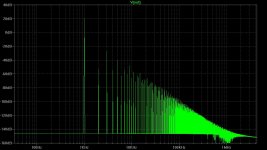I am sure all new F5 builders will find it to be an easy build. Quite amazing given the level of performance that is achieved. If you can solder and place numbers appropriately, your good to go. Perhaps before fets are distributed, we can start a checklist thread where more experienced builders can do a step by step to firing it up.
have not tryed them. but they are not driving dual rectifiers? are they?
i think they are singel rectifier and commond ground.
Hi AudioSan,
I'm not sure what you meant but it contains dual bridge rectifiers in either TO220 or TO3P packages.
No diode heatsinks?
.
This is the issue.
For those of us who think our discrete devices have some impact on overall sound.
The Diode section was designed to be snapped off the whole board and have the diodes installed on a heatsink (with individual insulators of course).🙂
Hi Nelson
Could you please explain further this effect (ie sliding bias), with a hypothetical example.
'What if you remove the Source resistance altogether?
First off, you get the 44 amps. In addition, with Fets you get an output stage
that will deliver more Class A power at a given bias figure due to the square
law character of the Fets."
Moreover, can this technique of parrelleling diodes with source resistors reduce the effects of crossover distortion on regular source follower output stages (eg BA2 output)
Appologies to everyone if this has been discussed in detail. I am new here 😀
Could you please explain further this effect (ie sliding bias), with a hypothetical example.
'What if you remove the Source resistance altogether?
First off, you get the 44 amps. In addition, with Fets you get an output stage
that will deliver more Class A power at a given bias figure due to the square
law character of the Fets."
Moreover, can this technique of parrelleling diodes with source resistors reduce the effects of crossover distortion on regular source follower output stages (eg BA2 output)
Appologies to everyone if this has been discussed in detail. I am new here 😀
Last edited:
The slight of hand, I believe, is that he means more Class A/B power. If you listen carefully, you can here the Klunk.
The slight of hand, I believe, is that he means more Class A/B power. If you listen carefully, you can here the Klunk.
Yes I tend to agree with that assumption however when he starts talking about square law of the mosfets (and not just reduced voltage drop across the "shorted" source resistor) I am thinking there could be some hidden treasures here.
Nelson often puts in hidden treasures of information in his articles that often go unnoticed.
Last edited:
Ok
I will keep hush, from now on.
Need to spend more time building and sleeping (4am here) and less time thinking.
Thinking is no good when you are running on one and half brain cells.
😀
I will keep hush, from now on.
Need to spend more time building and sleeping (4am here) and less time thinking.
Thinking is no good when you are running on one and half brain cells.
😀
Last edited:
Ok
Thinking is no good when you are running on one and half brain cells.
😀
I have no cells
I'm the sole one

I still have two functioning brain cells left - and they are running on caffeine 😀😀😀
Hi Nelson
Could you please explain further this effect (ie sliding bias), with a hypothetical example.
'What if you remove the Source resistance altogether?
First off, you get the 44 amps. In addition, with Fets you get an output stage
that will deliver more Class A power at a given bias figure due to the square
law character of the Fets."
Moreover, can this technique of parrelleling diodes with source resistors reduce the effects of crossover distortion on regular source follower output stages (eg BA2 output)
Appologies to everyone if this has been discussed in detail. I am new here 😀
Nelson you are one clever bastard.
I have discovered the magic of the diodes.
I will keep hush Zen Mod
So the diode keeps the opposing fet from fully turning off like it would during normal PP operation, interesting. I got new scope probes coming. Will have to take a look.
My patent 3,995,228 was submitted September 1975, and as
far as I can see describes a circuit which would do either, but
addresses Class A specifically. The basic circuit is similar to,
but predates the work of Cordell and separately, Hawksford.
They both obviously intended Class AB operation.
As an aside, I developed an extremely interesting circuit in
this area just as I was walking out the door at Threshold.
It remains a secret.
Interesting statement by GRollins.
Now, perhaps if there were some way to keep the devices warmed up, and the heatsinks' thermal mass at equilibrium, and so forth...perhaps then the circuit might stand a chance of sounding like it was class A.
Grey
These are two separate issues. The characteristics of the
output devices are dependent on temperature, and typically
an amp should be allowed to warm up before being adjusted
for optimal use. In my amps, we reach higher transconductance
in the Mosfets at the higher temperatures, so there will be less
distortion. This is also where we do any adjustment.
Of course warming up usually also means a shift in bias, and
here we have been talking (I think) about means of automatically
adjusting bias, which implies temperature independence.
So the diode keeps the opposing fet from fully turning off like it would during normal PP operation, interesting. I got new scope probes coming. Will have to take a look.
If I start to explain I risk getting kicked out of the Pass Pub, Blowing up my last 1.5 brain cells, getting permanently banned, losing my claim for the dumbest of the dummies forever and 42 will take on a new meaning.
All I am going to say is I wish I had of thought of this.
It was staring at me a few times when I was playing with this circuit a while back, but the brain cells let me down (not sure if I need more or less).
I have enormous respect for Nelson. Nelson has a knack of coming up with ideas that are so simple they are brilliant.
Last edited:
Nelson Pass Magic
The good old Nelson Pass Diode Trick
15V peak into 3 Ohms, with bias of 1.3 A, and 24V rails
Left image is without diode, right image is with diode
The good old Nelson Pass Diode Trick
15V peak into 3 Ohms, with bias of 1.3 A, and 24V rails
Left image is without diode, right image is with diode
Attachments
Last edited:
Definnitely not working as hard, is it. The BA output stage is going .to love this
Last edited:
So I love trying to figure this out. It would seem that an interesting sreenshot would show a picture of what is happening to the response of the get with just the resistor and then with the diode added. I am goin to try this and see what it shows about the response change.
- Status
- Not open for further replies.
- Home
- Amplifiers
- Pass Labs
- F5 Turbo is posted


